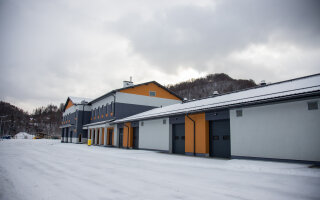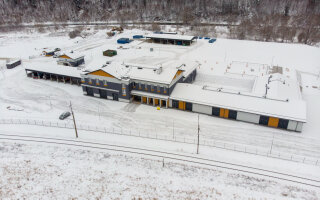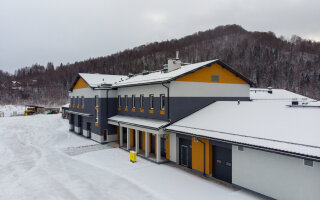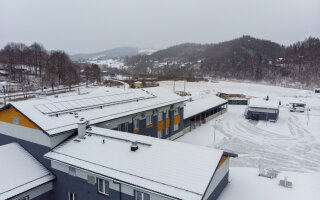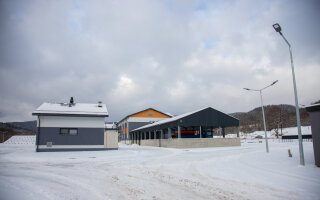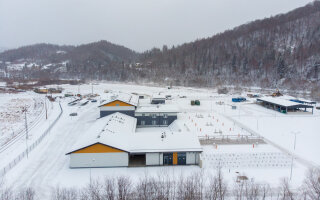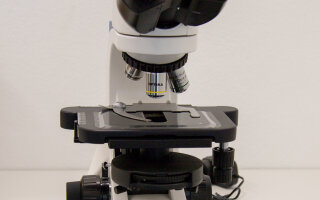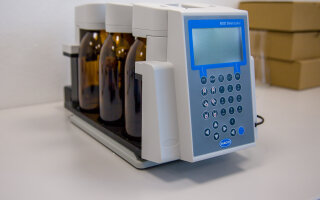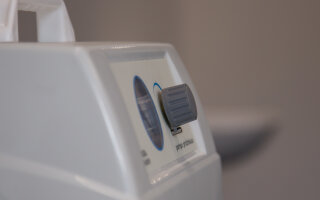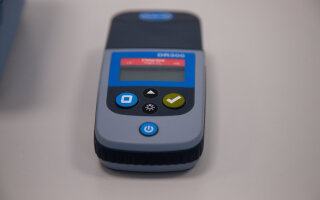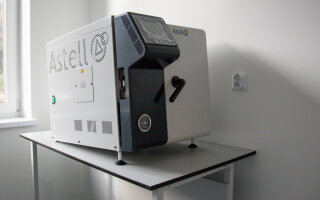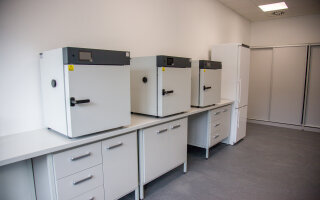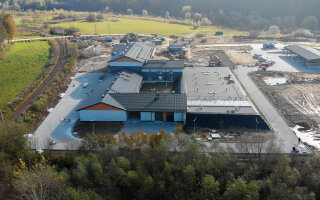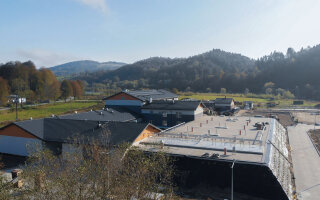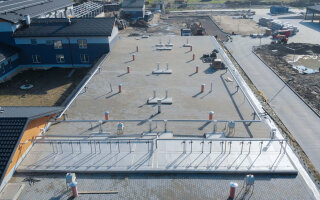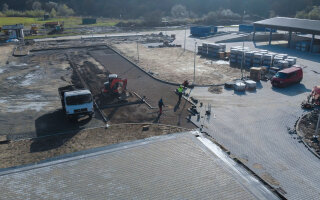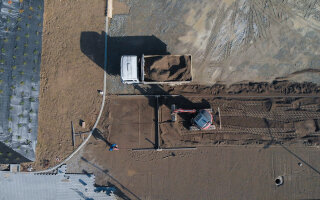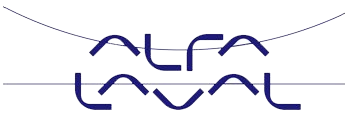Investment completed - Sewage Treatment Plant and Selective Waste Collection Point in Muszyna
21.01.2021
The newly created sewage treatment plant will enable effective treatment of wastewater from the residents currently living in the area of Muszyna. As part of the investment, professional facilities for the selective collection of waste received from the Muszyna area were built along with the waste reloading point for final disposal outside the area of the Muszyna Municipality. Schwander Polska has completed the following tasks: Reconstruction and expansion of the wastewater treatment plant in Muszyna and Construction of a Selective Waste Collection Point.
The idea of closed circle economy and the MBR sewage treatment plant in Muszyna
The European Union focuses on the circular economy, i.e. an economic concept in which products, materials and raw materials should remain in the economy for as long as possible, and the generation of waste should be minimized as much as possible. Wastewater treatment plants in the proprietary technology of Schwander Polska, based on MBR (membrane bioreactor), perfectly fit into the concept of circular economy by:
The best wastewater treatment technology on the market - MBR
The wastewater treatment plant was built on the basis of the latest wastewater treatment technology: MBR (Membrane Biological Reactor technology) - based on membrane microfiltration, recommended in European Union directives as BAT - the best available method of wastewater treatment. Thanks to the combination of elements of the activated sludge classic technology and microfiltration membranes filtration, the wastewater treated in MBR reactors meets the highest quality requirements, both in terms of physicochemical and microbiological standards. To illustrate -the quality of the effluent purified can be compared to the first-class purity of flowing water.
The wastewater treatment plant was built on the basis of the latest wastewater treatment technology: MBR (Membrane Biological Reactor technology) - based on membrane microfiltration, recommended in European Union directives as BAT - the best available method of wastewater treatment. Thanks to the combination of elements of the activated sludge classic technology and microfiltration membranes filtration, the wastewater treated in MBR reactors meets the highest quality requirements, both in terms of physicochemical and microbiological standards. To illustrate -the quality of the effluent purified can be compared to the first-class purity of flowing water.
How is the wastewater treatment process carried out in the MBR treatment plant?
In MBR technology, the following stages of wastewater treatment are distinguished:
In MBR technology, the following stages of wastewater treatment are distinguished:
- mechanical cleaning - separation of solid contaminants such as kitchen waste, paper and textiles, sand and grease;
- biological treatment - the use of microorganisms (mainly bacteria) to remove nitrogen and phosphorus compounds from wastewater;
- membrane filtration - sewage flows through a membrane where all remaining solid impurities, most pathogenic bacteria and viruses, most microplastics and 90-100% pharmaceuticals present in the sewage are separated;
- dehydration and hygienization of excess sludge formed in the wastewater treatment process.
Removal of microplastics
The problem of microplastics has only recently reached high visibility. In recent years, the presence of plastic particles has been revealed both in marine organisms as well as in bottled and even underground water. Wastewater treatment plants are recognized as one of the important sources of microplastics in surface waters. The presence of this type of pollutants in waters poses a real danger to aquatic organisms. Microplastic in sewage comes mainly from cosmetics, as well as from clothes from which it is rinsed out during washing. Research is ongoing on the impact of microplastics on the human body, but it is assumed that it affects, inter alia - on the endocrine system. Therefore, further efforts are made to reduce its emissions to the environment.
The European Union is currently working on solutions to stop this harmful process through, for example, Directive of the European Parliament and of the Council on the limitation of the effects of certain plastic products on the environment ("Single-Use Plastics Directive"). A very important mechanism in this Directive are extended producer responsibility programs covering cleaning costs.
The effectiveness of MBR treatment plants in removing microplastics has been confirmed by scientific research. During the analysis of particles down to 50 μm, it was shown that no microplastics were found in the wastewater treated by microfiltration membranes - for this breakthrough discovery Alfa Laval membrane modules (also used in the wastewater treatment plant in Muszyna) were awarded the most prestigious award in the field of environmental protection in the world - Energy Globe Award 2018. The research was carried out by Plastic Change in cooperation with Alfa Laval and Danish research institutions: Aarhus University, Roskilde University and EnviDan.
Removal of pharmaceuticals
Currently, pollutants which are most difficult to remove and at the same time very dangerous to the environment - are pharmaceuticals and their metabolites. These substances are present not only in the wastewater flowing to the treatment plant, but also in the treated wastewater discharged to the receiving body. Unfortunately, more and more widely and precisely performed tests for the presence of pharmaceuticals in the aquatic environment (including sewage and drinking water) give positive results. This proves a global problem that carries a number of threats, not only to aquatic organisms, but above all to human health and life.
In the course of independent studies on the removal of pharmaceuticals from wastewater carried out by the Warsaw University of Technology, it turned out that thanks to the use of MBR over 90% of pharmaceuticals are removed from wastewater (these rates often reach 100%) – these results cannot be attributed to any conventional technology.
All of this makes the MBR method of wastewater treatment the number one in removal of pharmaceuticals from wastewater in the treatment process. It should be highlighted that pharmaceuticals such as diclofenac and clofibric acid, which are among the most difficult to remove pharmaceuticals from wastewater, were removed in more than 72% in wastewater treatment systems with membrane bioreactors.
The problem of microplastics has only recently reached high visibility. In recent years, the presence of plastic particles has been revealed both in marine organisms as well as in bottled and even underground water. Wastewater treatment plants are recognized as one of the important sources of microplastics in surface waters. The presence of this type of pollutants in waters poses a real danger to aquatic organisms. Microplastic in sewage comes mainly from cosmetics, as well as from clothes from which it is rinsed out during washing. Research is ongoing on the impact of microplastics on the human body, but it is assumed that it affects, inter alia - on the endocrine system. Therefore, further efforts are made to reduce its emissions to the environment.
The European Union is currently working on solutions to stop this harmful process through, for example, Directive of the European Parliament and of the Council on the limitation of the effects of certain plastic products on the environment ("Single-Use Plastics Directive"). A very important mechanism in this Directive are extended producer responsibility programs covering cleaning costs.
The effectiveness of MBR treatment plants in removing microplastics has been confirmed by scientific research. During the analysis of particles down to 50 μm, it was shown that no microplastics were found in the wastewater treated by microfiltration membranes - for this breakthrough discovery Alfa Laval membrane modules (also used in the wastewater treatment plant in Muszyna) were awarded the most prestigious award in the field of environmental protection in the world - Energy Globe Award 2018. The research was carried out by Plastic Change in cooperation with Alfa Laval and Danish research institutions: Aarhus University, Roskilde University and EnviDan.
Removal of pharmaceuticals
Currently, pollutants which are most difficult to remove and at the same time very dangerous to the environment - are pharmaceuticals and their metabolites. These substances are present not only in the wastewater flowing to the treatment plant, but also in the treated wastewater discharged to the receiving body. Unfortunately, more and more widely and precisely performed tests for the presence of pharmaceuticals in the aquatic environment (including sewage and drinking water) give positive results. This proves a global problem that carries a number of threats, not only to aquatic organisms, but above all to human health and life.
In the course of independent studies on the removal of pharmaceuticals from wastewater carried out by the Warsaw University of Technology, it turned out that thanks to the use of MBR over 90% of pharmaceuticals are removed from wastewater (these rates often reach 100%) – these results cannot be attributed to any conventional technology.
All of this makes the MBR method of wastewater treatment the number one in removal of pharmaceuticals from wastewater in the treatment process. It should be highlighted that pharmaceuticals such as diclofenac and clofibric acid, which are among the most difficult to remove pharmaceuticals from wastewater, were removed in more than 72% in wastewater treatment systems with membrane bioreactors.
MBR sewage treatment plant in Muszyna - devices, from the left: decanter centrifuge, blowers
MBR sewage treatment plant in Muszyna - filtration system
Benefits from using MBR
The advantages of the MBR wastewater treatment plant in the proprietary technology of Schwander Polska include:
The advantages of the MBR wastewater treatment plant in the proprietary technology of Schwander Polska include:
- lack of odors,
- 2-4 times reduction of the area occupied by the sewage treatment plant compared to traditional technologies,
- reducing the consumption of electricity and chemicals,
- operating in automatic mode, with remote supervision mode,
- excellent quality of treated sewage which can be compared to the first class of flowing water purity,
- the possibility of reusing the treated sewage,
- the highest level of microplastics, pharmaceuticals, bacteria and pathogenic viruses elimination among all available wastewater treatment technologies,
- harmonious integration of the building into the surrounding landscape,
- environmental protection, MBR technology can be used in protected areas,
- MBR technology is recommended by the European Union as the best wastewater treatment method available on the market.
The idea of closed circle economy and the MBR sewage treatment plant in Muszyna
The European Union focuses on the circular economy, i.e. an economic concept in which products, materials and raw materials should remain in the economy for as long as possible, and the generation of waste should be minimized as much as possible. Wastewater treatment plants in the proprietary technology of Schwander Polska, based on MBR (membrane bioreactor), perfectly fit into the concept of circular economy by:
- reuse of wastewater treated as process water for the operation of sewage treatment plant equipment (sieve rinsing in a grease and grit removal, rinsing the centrifuge, polymer digestion, rinsing membrane modules, rinsing the supply wastewater collection station, cleaning the yard, vehicles), which saves usable water,
- thanks to the excellent quality of the treated sewage, after additional UV disinfection, it is possible to use the water recovered from sewage in complete safety for: maintenance of cleanliness, irrigation of green areas, artificial snowmaking, powering car washes, etc., which helps to save valuable drinking water resources,
- there are plans for the future to recover raw materials and energy through the hydrothermal carbonization process. It will enable the disposal of residue and sewage sludge generated in the treatment process, and what is more after additional gasification, the production of the fuel of the future - hydrogen - will be possible, as well as the recovery of leachate rich in nitrogen and phosphorus compounds for the production of fertilizers,
- it is also planned to submit the filtrate to a plasmolysis process, which enables the production of green hydrogen from treated wastewater. This innovative technology will not only allow the production of the most desirable form of hydrogen from treated wastewater, but will also make the treated wastewater meet even more stringent quality standards.
Laboratory - MBR sewage treatment plant in Muszyna
Perfect solution for tourism
The sewage treatment plant and Selective Waste Collection Point in Muszyna as pro-ecological buildings are characterized by high-quality architecture that harmonizes perfectly with the technical solutions used. The pleasing to the eye shape of the building harmonizes with modern wastewater treatment technologies and can become, for example, an attractive element of environmental education for children and youth. Due to the 100% neutralization of odors, it is a perfect solution for tourist areas - buildings and tanks are fully hermetic and equipped with advanced deodorization systems, thanks to which neither residents nor tourists will experience any inconvenience related to the functioning of the facility.
In wastewater treatment plants, which are designed for areas visited by tourists, the issue of increasing flow of wastewater during the tourist season is quite a challenge. According to the report of the Supreme Audit Office, during the tourist season in many places the number of tourists periodically exceeds five or six times the number of residents. During the period of increased tourist traffic, the amount of sewage flowing into the treatment plant increases by up to 300%. A properly prepared MBR treatment plant offers incomparably greater flexibility than conventional wastewater treatment technologies, allowing trouble-free and stable operation of the installation during the tourist season as well as after this period.
Safety - no virological and bacteriological risk
Wastewater treatment plants implemented by Schwander Polska, due to the specificity of MBR technology, guarantee even higher safety during exploatation, which is extremely important due to the increased risk associated with the COVID-19 pandemic caused by the SARS-CoV-2 virus.
Covered tanks prevent the spread of harmful substances, e.g. poisonous odors, aerosols containing toxic substances and gaseous bacteria and viruses. The treated sewage is free of pathogenic bacteria and viruses, and the treatment plant employee has no contact with the sewage as part of the routine operation of the MBR sewage treatment plant.
The sewage treatment plant and Selective Waste Collection Point in Muszyna as pro-ecological buildings are characterized by high-quality architecture that harmonizes perfectly with the technical solutions used. The pleasing to the eye shape of the building harmonizes with modern wastewater treatment technologies and can become, for example, an attractive element of environmental education for children and youth. Due to the 100% neutralization of odors, it is a perfect solution for tourist areas - buildings and tanks are fully hermetic and equipped with advanced deodorization systems, thanks to which neither residents nor tourists will experience any inconvenience related to the functioning of the facility.
In wastewater treatment plants, which are designed for areas visited by tourists, the issue of increasing flow of wastewater during the tourist season is quite a challenge. According to the report of the Supreme Audit Office, during the tourist season in many places the number of tourists periodically exceeds five or six times the number of residents. During the period of increased tourist traffic, the amount of sewage flowing into the treatment plant increases by up to 300%. A properly prepared MBR treatment plant offers incomparably greater flexibility than conventional wastewater treatment technologies, allowing trouble-free and stable operation of the installation during the tourist season as well as after this period.
Safety - no virological and bacteriological risk
Wastewater treatment plants implemented by Schwander Polska, due to the specificity of MBR technology, guarantee even higher safety during exploatation, which is extremely important due to the increased risk associated with the COVID-19 pandemic caused by the SARS-CoV-2 virus.
Covered tanks prevent the spread of harmful substances, e.g. poisonous odors, aerosols containing toxic substances and gaseous bacteria and viruses. The treated sewage is free of pathogenic bacteria and viruses, and the treatment plant employee has no contact with the sewage as part of the routine operation of the MBR sewage treatment plant.







